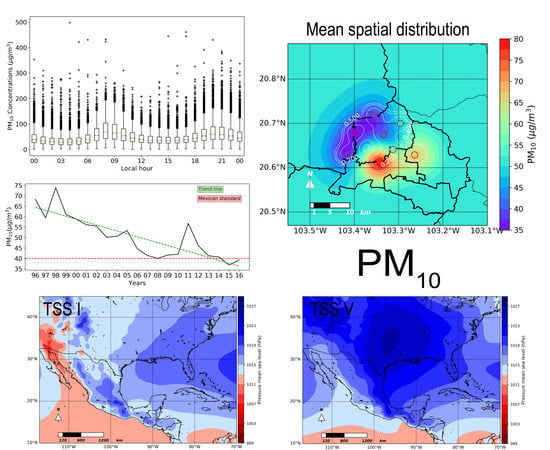Atmospheric Pollution by PM10 and O3 in the Guadalajara Metropolitan Area, Mexico
Abstract
1. Introduction
2. Data and Methodology
2.1. Area of Study
2.2. Observation Data
2.3. Methods
3. Results and Discussion
3.1. Temporal and Spatial Analysis of PM10
3.2. Temporal and Spatial Analysis of O3
3.3. TSS Classification
4. Conclusions
Author Contributions
Funding
Acknowledgments
Conflicts of Interest
Appendix
| Station | Station Classification | Main Sources Near the Station | Surroundings Description |
|---|---|---|---|
| Atemajac (Ate) | Urban | Area sources | Residential and commercial area |
| Oblatos (Obl) | Urban | Area sources | Residential and commercial area |
| Loma Dorada (Dor) | Urban | Biogenic sources | Densely populated zone, few green areas |
| Tlaquepaque (Tla) | Urban | Area sources | Residential and commercial area with small pottery workshops |
| Miravalle (Mir) | Urban | Point sources | Industrial and residential area, no green areas |
| Las Aguilas (Agu) | Urban | Area sources | Residential area |
| Vallarta (Val) | Urban | Area sources | Residential zone with wooded areas |
| Centro (Cen) | Urban | Area sources | Commercial area with houses |
| Pollutant | Sampling Time | Mexican Norm | WHO Recommendation |
|---|---|---|---|
| PM10 (μg/m3) | 24 h | 75.0 | 50.0 |
| 1 year | 40.0 | 20.0 | |
| O3 (ppm) | 1 h | 0.095 | - |
| 8 h | 0.070 | 0.050 |
| TSS | Rainy Season | Dry Season |
|---|---|---|
| TSS I | 0.0254 | 0.0244 |
| TSS II | 0.0386 | 0.0284 |
| TSS III | 0.0373 | 0.0280 |
| TSS IV | 0.0304 | 0.0226 |
| TSS V | 0.0273 | 0.0229 |
| TSS VI | 0.0295 | 0.0311 |


References
- Penner, J.P.; Andreae, M.; Annegarn, H.; Barrie, L.; Feichter, J.; Hegg, D.; Achuthan, J.; Leaitch, R.; Murphy, D.; Nganga, J.; et al. Aerosols, their direct and indirect effects, in: Climate Change 2001: The Scientific Basis. In Contribution of Working Group I to the Third Assessment Report of the Intergovernmental Panel on Climate Change; Houghton, J.T., Ding, Y., Griggs, D.J., Noguer, M., Van der Linden, P.J., Dai, X., Maskell, K., Johnson, C.A., Eds.; Cambridge University Press: Cambridge, UK, 2001; pp. 289–348. [Google Scholar]
- Pope, C.A., III; Dockery, D.W. Health effects of fine particulate air pollution: Lines that connect. J. Air Waste Manag. 2006, 56, 709–742. [Google Scholar] [CrossRef]
- Zhang, J.; Mauzerall, D.L.; Zhu, T.; Liang, S.; Ezzati, M.; Remais, J.V. Environmental health in China: Progress towards clean air and safe water. Lancet 2010, 375, 1110–1119. [Google Scholar] [CrossRef]
- PROAIRE (2011). Programa Para Mejorar la Calidad del Aire Jalisco 2011–2020. Inventario de Emisiones. Available online: http://www.semades.jalisco (accessed on 22 April 2018).
- Kanda, I.; Basaldud, R.; Magaña, M.; Retama, A.; Kubo, R.; Wakamatsu, S. Comparison of ozone production regimes between two Mexican cities: Guadalajara and Mexico City. Atmosphere 2016, 7, 91. [Google Scholar] [CrossRef]
- Benítez-García, S.E.; Kanda, I.; Wakamatsu, S.; Okazaki, Y.; Kawano, M. Analysis of criteria air pollutant trends in three Mexican metropolitan areas. Atmosphere 2014, 5, 806–829. [Google Scholar] [CrossRef]
- Figueroa, A.; Davydova-Belitskaya, V.; Chávez, G.G.; Gallardo, T.P.; Orozco-Medina, M.G. PM10 y O3 como factores de riesgo de mortalidad por enfermedades cardiovasculares y neumonía en la Zona Metropolitana de Guadalajara, Jalisco, México. Ingeniería 2016, 20, 14–23. [Google Scholar]
- Belitskaya, V.D.; Skiba, Y.N.; Martínez, A.; Bulgakov, S.N. Modelación matemática de los niveles de contaminación en la ciudad de Guadalajara, Jalisco, México. Parte II. Modelo numérico de transporte de contaminantes y su adjunto. Rev. Int. Contam. Ambient. 2001, 17, 97–107. [Google Scholar]
- Tereshchenko, I.E.; Filonov, A.E. Acerca de las causas de las elevadas concentraciones de ozono en la atmósfera de la Zona Metropolitana de Guadalajara, en octubre de 1996. GEOS 1997, 17, 54–59. [Google Scholar]
- Sánchez, H.U.R.; García, M.D.A.; Bejaran, R.; Guadalupe, M.E.G.; Vázquez, A.W.; Toledano, A.C.P.; de la Torre Villasenor, O. The spatial–temporal distribution of the atmospheric polluting agents during the period 2000–2005 in the Urban Area of Guadalajara, Jalisco, Mexico. J. Hazard. Mater. 2009, 165, 1128–1141. [Google Scholar] [CrossRef] [PubMed]
- Stohl, A.; Hittenberger, M.; Wotawa, G. Validation of the Lagrangian particle dispersion model FLEXPART against large-scale tracer experiment data. Atmos. Environ. 1998, 32, 4245–4264. [Google Scholar] [CrossRef]
- Varotsos, C.; Efstathiou, M.; Tzanis, C.; Deligiorgi, D. On the limits of the air pollution predictability: The case of the surface ozone at Athens, Greece. Environ. Sci. Pollut. Res. 2012, 19, 295–300. [Google Scholar] [CrossRef] [PubMed]
- Bei, N.; Li, G.; Zavala, M.; Barrera, H.; Torres, R.; Grutter, M.; Gutiérrez, W.; García, M.; Ruiz-Suarez, L.G.; Ortinez, A.; et al. Meteorological overview and plume transport patterns during CalMex 2010. Atmos. Environ. 2013, 70, 477–489. [Google Scholar] [CrossRef]
- Bei, N.; Li, G.; Huang, R.J.; Cao, J.; Meng, N.; Feng, T.; Molina, L.T. Typical synoptic situations and their impacts on the wintertime air pollution in the Guanzhong basin, China. Atmos. Chem. Phys. 2016, 16, 7373–7387. [Google Scholar] [CrossRef]
- De Foy, B.; Varela, J.R.; Molina, L.T.; Molina, M.J. Rapid ventilation of the Mexico City basin and regional fate of the urban plume. Atmos. Chem. Phys. 2006, 6, 2321–2335. [Google Scholar] [CrossRef]
- Notario, A.; Adame, J.A.; Bravo, I.; Cuevas, C.A.; Aranda, A.; Díaz-de-Mera, Y.; Rodríguez, A. Air pollution in the plateau of the Iberian Peninsula. Atmos. Res. 2014, 145, 92–104. [Google Scholar] [CrossRef]
- Grundstrom, M.; Tang, L.; Hallquist, M.; Nguyen, H.; Chen, D.; Pleijel, H. Influence of atmospheric circulation patterns on urban air quality during the winter. Atmos. Pollut. Res. 2015, 6, 278–285. [Google Scholar] [CrossRef]
- Mosiño, A.P. Una clasificación de las configuraciones del flujo aéreo en la República Mexicana. Rev. Ing. Hidraul. 1958, 12, 29–54. [Google Scholar]
- INEGI (2011). Censo de Población Y Vivienda 2010. Tabulados del Cuestionario Básico. México. Available online: http://www3.inegi.org.mx/sistemas/TabuladosBasicos/Default.aspx?c=27302 (accessed on 25 April 2018).
- Magaña, V.; Amador, J.A.; Medina, S. The midsummer drought over Mexico and Central America. J. Clim. 1999, 12, 1577–1588. [Google Scholar] [CrossRef]
- Secretaría de Medio Ambiente y Desarrollo Territorial. Calidad del Aire AMG. Available online: http://siga.jalisco.gob.mx/aire2017/Descargas (accessed on 5 March 2018).
- Secretaría de Medio Ambiente y Desarrollo Territorial. Sistema de Monitoreo Atmosférico de Jalisco. Available online: https://semadet.jalisco.gob.mx (accessed on 5 March 2018).
- CLICOM. Available online: http://clicom-mex.cicese.mx (accessed on 21 November 2017).
- CISL RDA: NCEP North American Regional Reanalysis (NARR). Available online: http://rda.ucar.edu/datasets/ds608.0/ (accessed on 25 May 2017).
- Lund, I.A. Map-pattern classification by statistical methods. J. Appl. Meteorol. 1963, 2, 56–65. [Google Scholar] [CrossRef]
- McDonald, J.H. Handbook of Biological Statistics; Sparky House Publishing: Baltimore, MD, USA, 2009; Volume 2, pp. 173–181. [Google Scholar]
- Pandey, B.; Agrawal, M.; Singh, S. Assessment of air pollution around coal mining area: Emphasizing on spatial distributions, seasonal variations and heavy metals, using cluster and principal component analysis. Atmos. Pollut. Res. 2014, 5, 79–86. [Google Scholar] [CrossRef]
- Fisher, R.A. Statistical Methods and Scientific Inference; Oliver & Boyd: Edinburgh, Scotland, UK, 1956. [Google Scholar]
- Tukey, J.W. The philosophy of multiple comparisons. Stat. Sci. 1991, 6, 100–116. [Google Scholar] [CrossRef]
- Stephens, S.; Madronich, S.; Wu, F.; Olson, J.B.; Ramos, R.; Retama, A.; Munoz, R. Weekly patterns of México City’s surface concentrations of CO, NOx, PM 10 and O3 during 1986–2007. Atmos. Chem. Phys. 2008, 8, 5313–5325. [Google Scholar] [CrossRef]
- Gobierno del Estado de Jalisco. Reglamento de la Ley Estatal del Equilibrio Ecológico y la Protección al Ambiente en Materia de Prevención y Control de Emisiones por Fuentes Móviles; Gobierno del Estado de Jalisco: Guadalajara, Jalisco, México, 2012. [Google Scholar]
- Nielsen-Gammon, J.W. The 2011 Texas drought. Texas Water J. 2012, 3, 59–95. [Google Scholar]
- Elkus, B.; Wilson, K.R. Photochemical air pollution: Weekend-weekday differences. Atmos. Environ. 1977, 11, 509–515. [Google Scholar] [CrossRef]
- Debaje, S.B.; Kakade, A.D. Weekend ozone effect over rural and urban site in India. Aerosol Air Qual. Res. 2006, 6, 322–333. [Google Scholar] [CrossRef]
- Heuss, J.M.; Kahlbaum, D.F.; Wolff, G.T. Weekday/weekend ozone differences: What can we learn from them? Air Waste Manag. Assoc. 2003, 53, 772–788. [Google Scholar] [CrossRef]
- Borrell P (2013). The Weekend Effect. Available online: http://www.rsc.org/chemistryworld/Issues/2003/May/weekend.asp (accessed on 5 October 2017).
- Willett, H.C. The relationship of total atmospheric ozone to the sunspot cycle. J. Geophys. Res. 1962, 67, 661–670. [Google Scholar] [CrossRef]
- Angell, J.K. On the relation between atmospheric ozone and sunspot number. J. Clim. 1989, 2, 1404–1416. [Google Scholar] [CrossRef]
- Rafiq, L.; Tajbar, S.; Manzoor, S. Long term temporal trends and spatial distribution of total ozone over Pakistan. EJRS 2017, 20, 295–301. [Google Scholar] [CrossRef]
- World Meteorological Organization (WMO). WMO Global Ozone Research and Monitoring Project; WMO: Geneva, Switzerland, 1985. [Google Scholar]
- World Meteorological Organization (WMO). Scientific Assessment of Ozone Depletion: 1998 (Executive Summary); WMO: Geneva, Switzerland, 1999. [Google Scholar]
- Coughlin, K.; Tung, K.K. Eleven-year solar cycle signal throughout the lower atmosphere. J. Geophys. Res. Atmos. 2004, 109. [Google Scholar] [CrossRef]
- Labitzke, K.; Van Loon, H. Associations between the 11-year solar cycle, the QBO and the atmosphere. Part I: The troposphere and stratosphere in the northern hemisphere in winter. J. Atmos. Sol. Terr. Phys. 1988, 50, 197–206. [Google Scholar] [CrossRef]
- Labitzke, K.; Van Loon, H. The signal of the 11-year sunspot cycle in the upper troposphere-lower stratosphere. Space Sci. Rev. 1997, 80, 393–410. [Google Scholar] [CrossRef]
- Chandra, S.; Ziemke, J.R.; Stewart, R.W. An 11-year solar cycle in tropospheric ozone from TOMS measurements. Geophys. Res. Lett. 1999, 26, 185–188. [Google Scholar] [CrossRef]
- Comrie, A.C.; Yarnal, B. Relationships between synoptic-scale atmospheric circulation and ozone concentrations in metropolitan Pittsburgh, Pennsylvania. Atmos. Environ. Part B Urban 1992, 26, 301–312. [Google Scholar] [CrossRef]

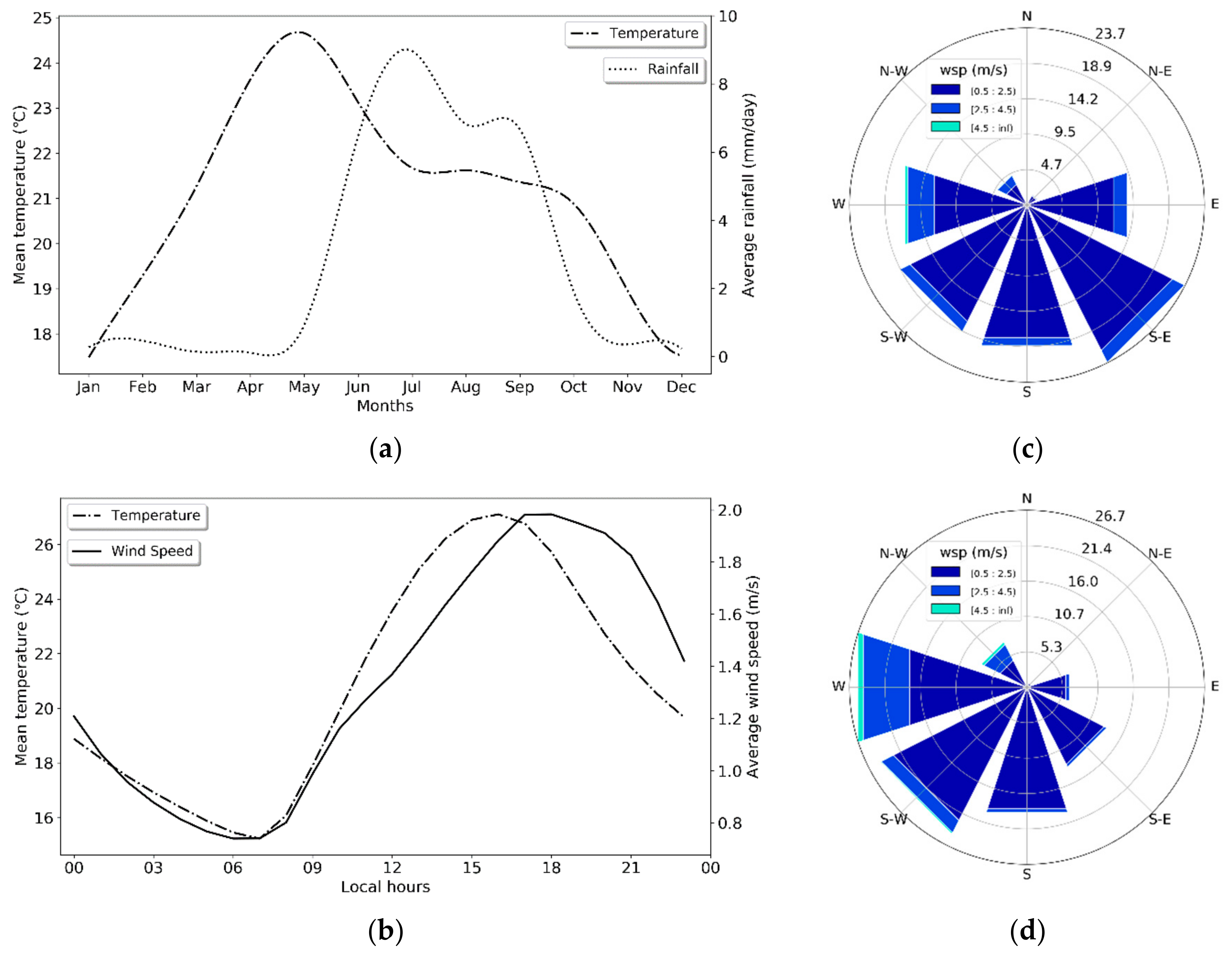
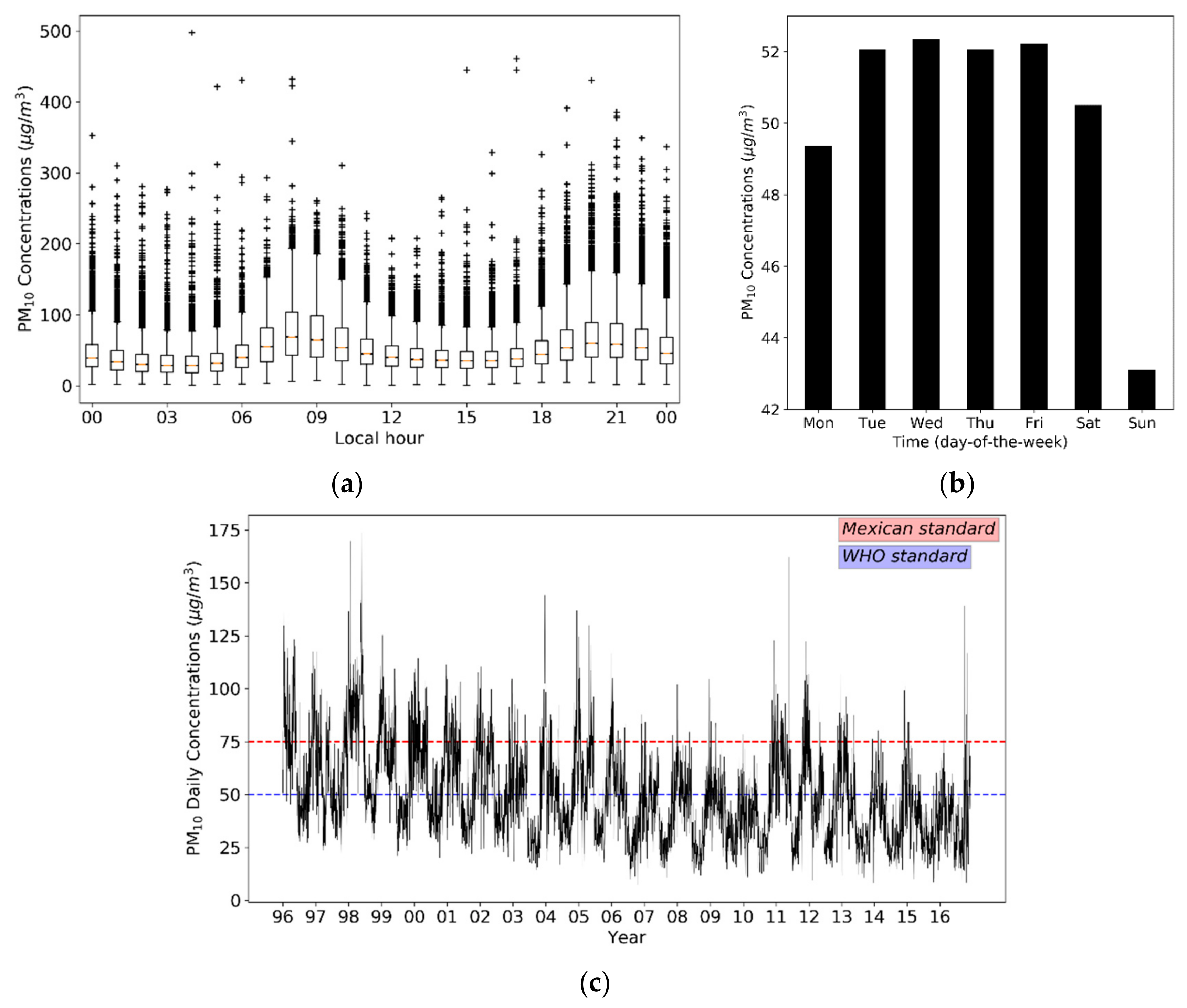
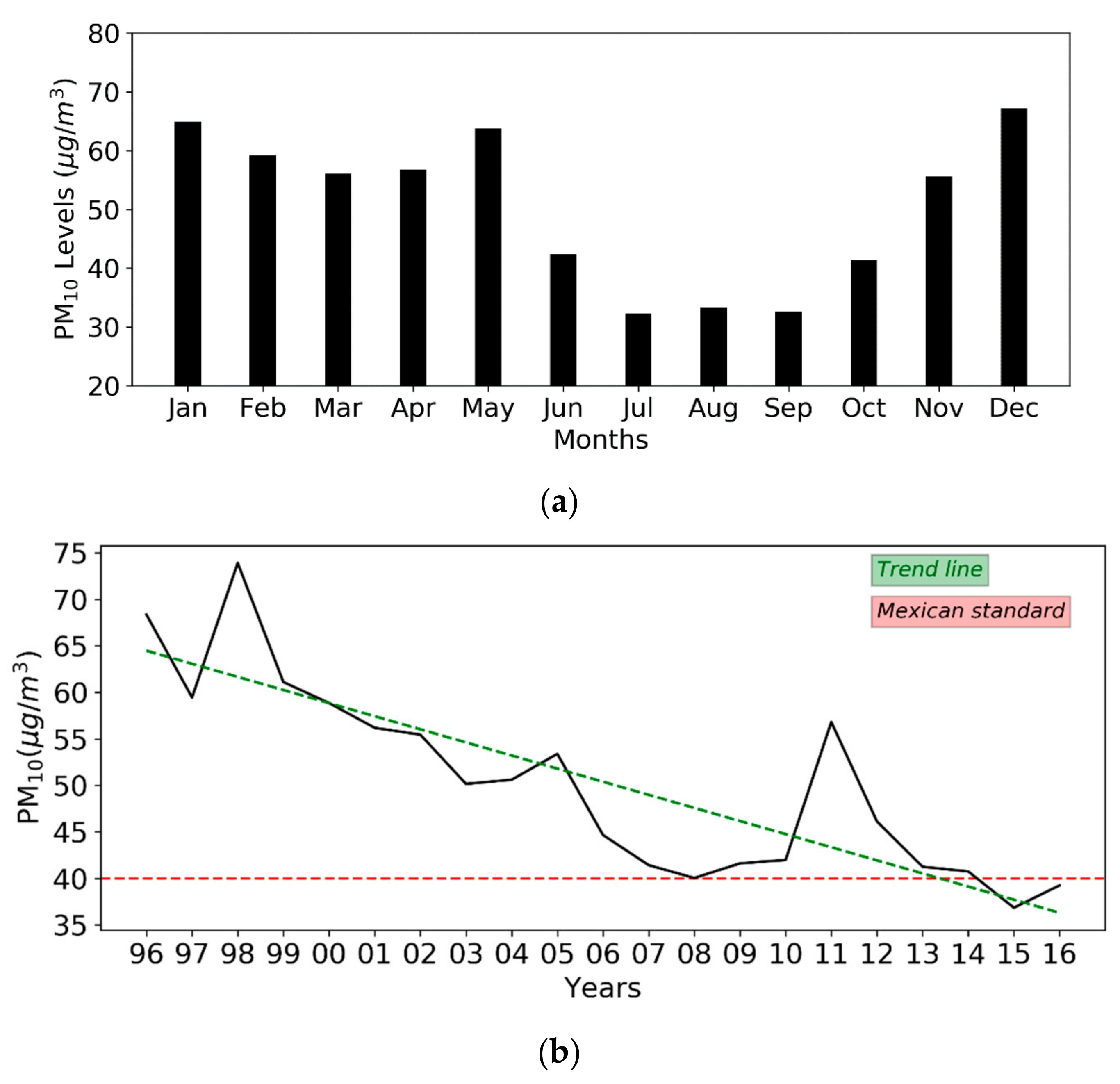
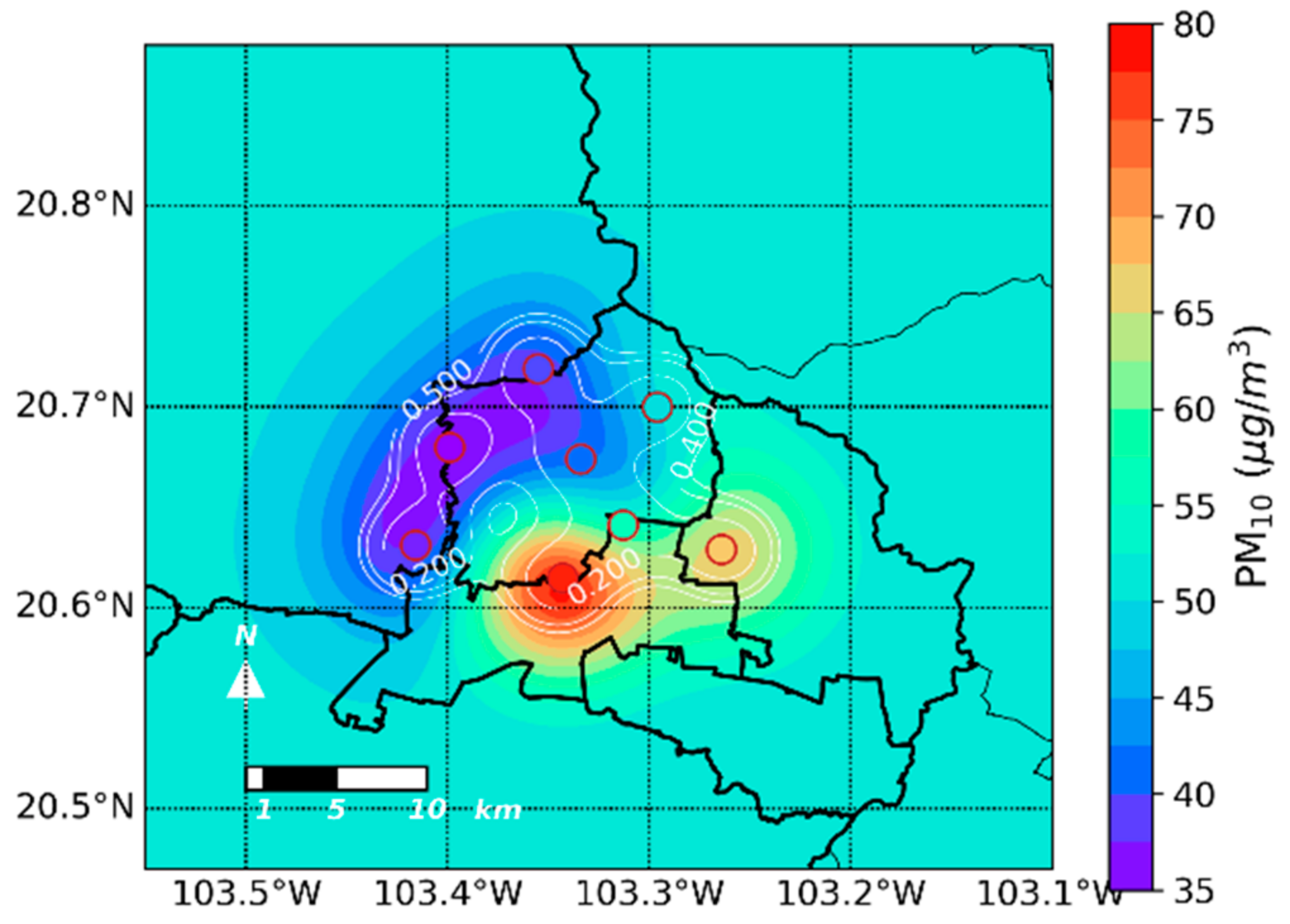
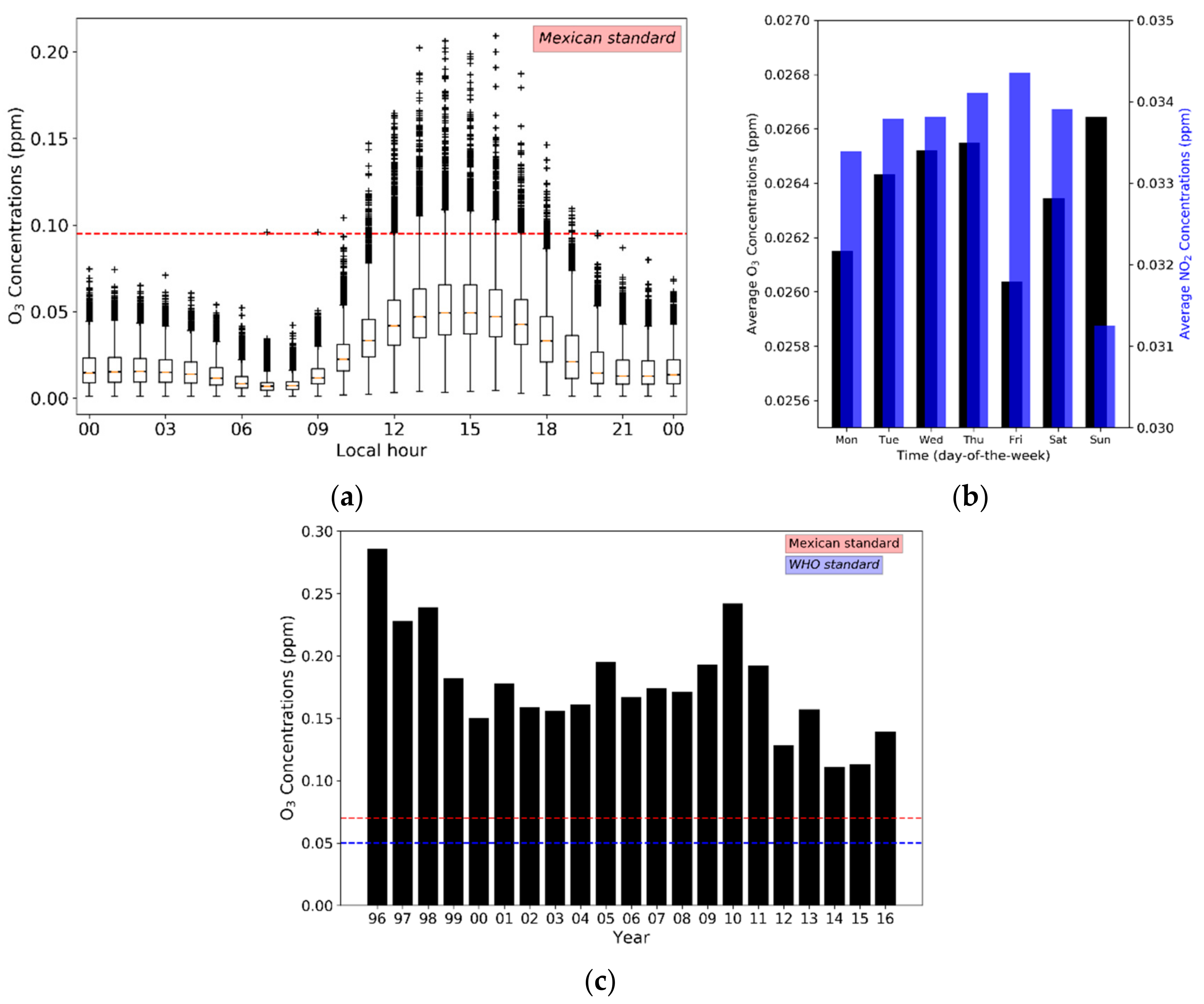
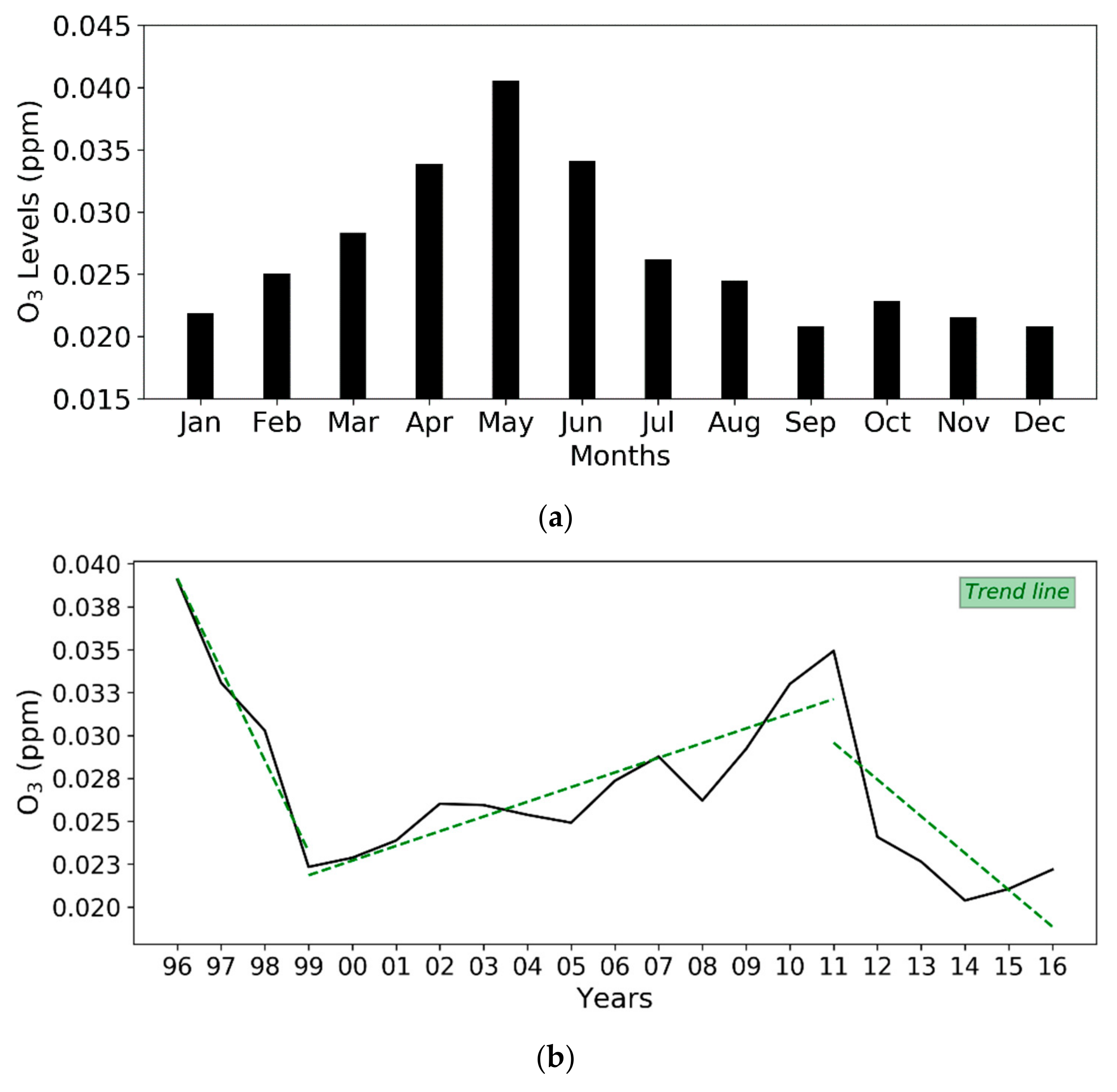
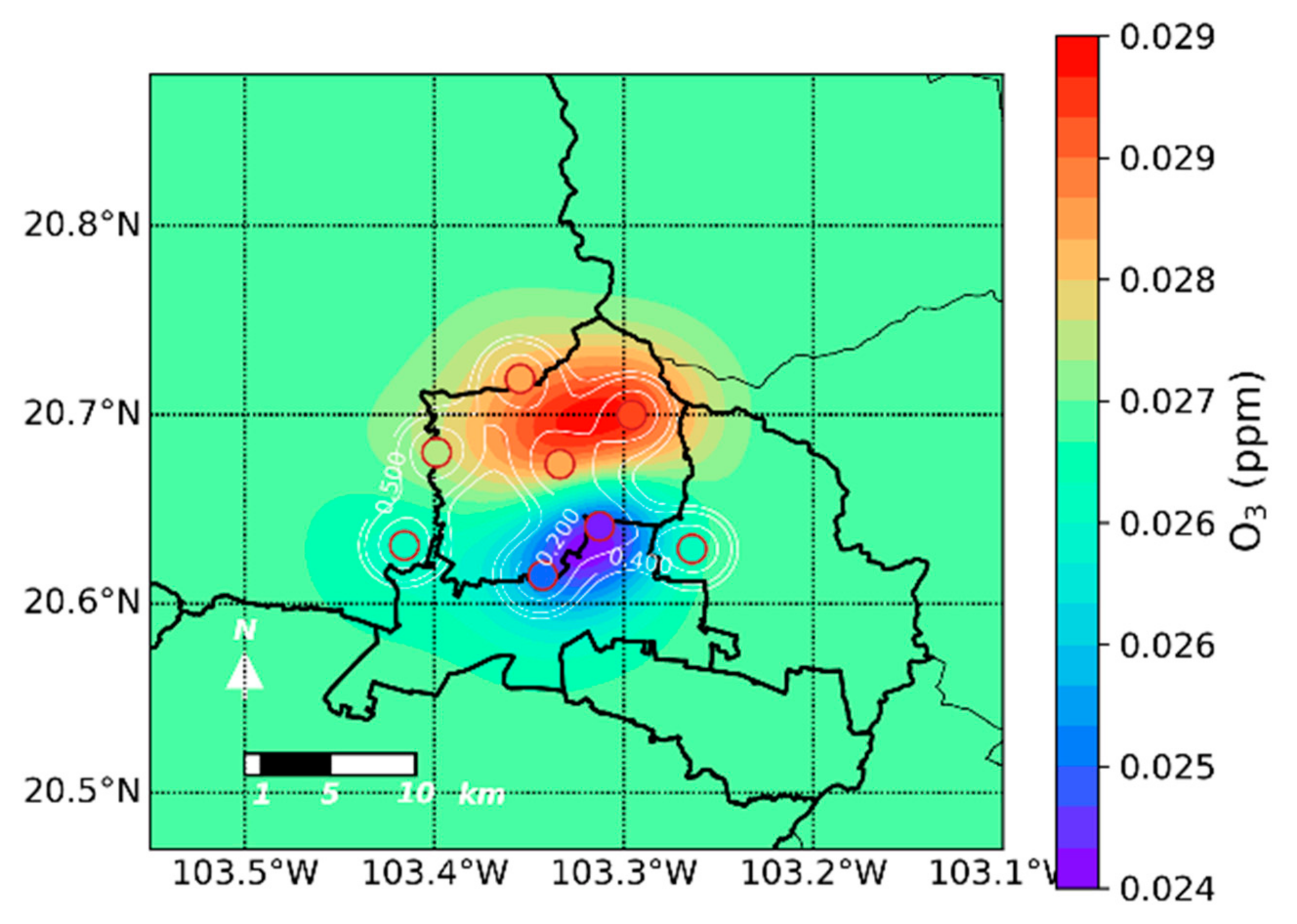
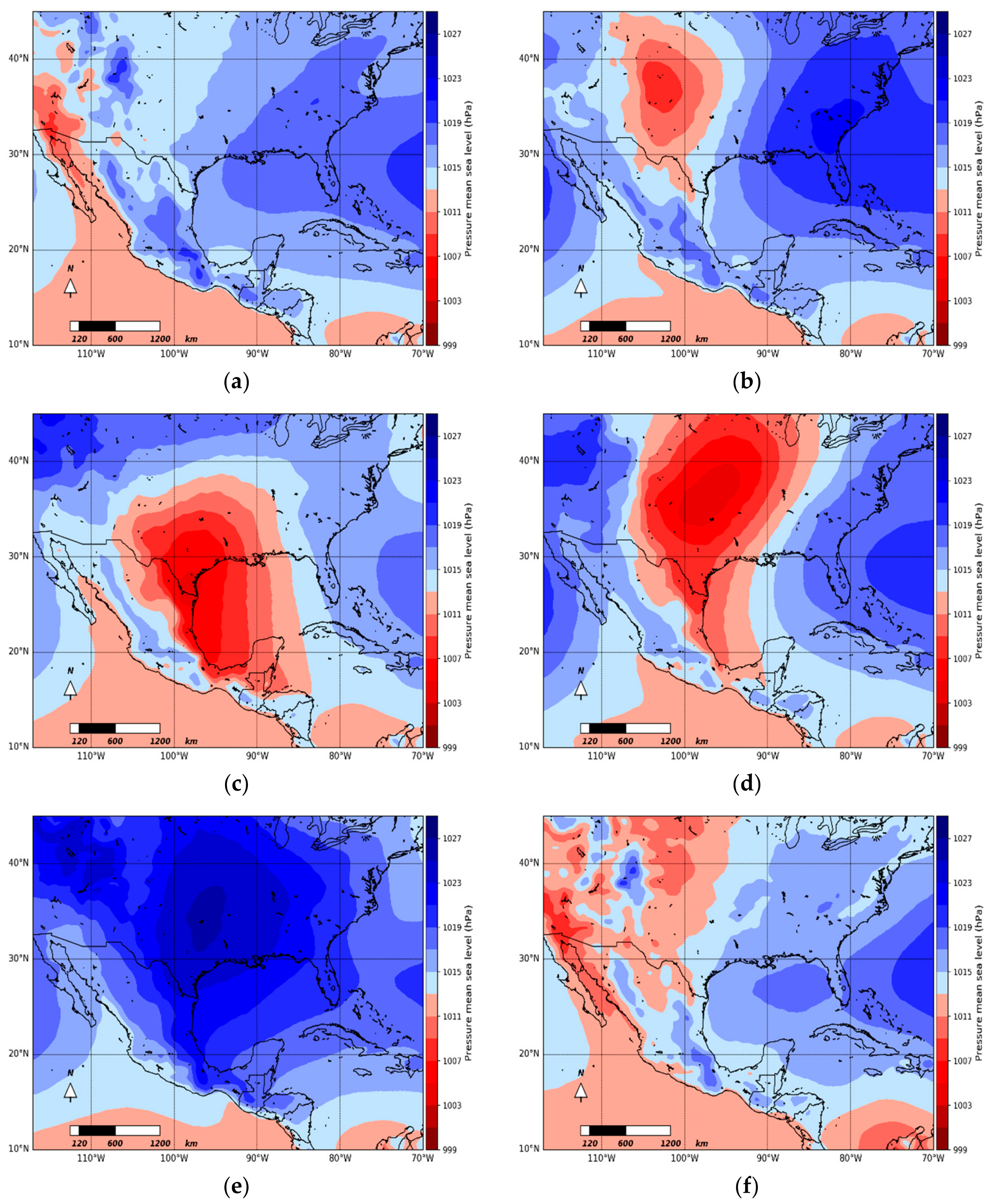
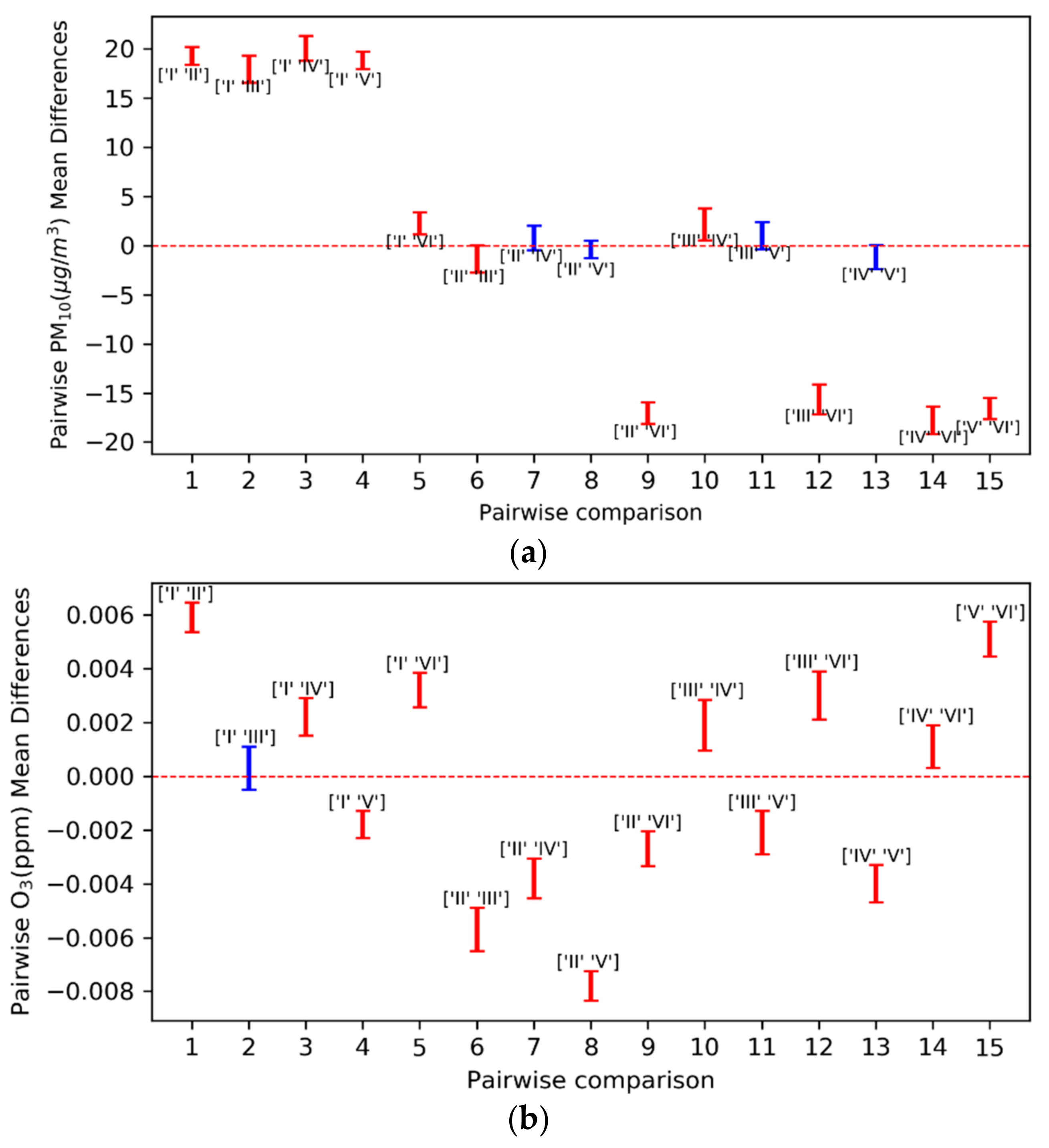
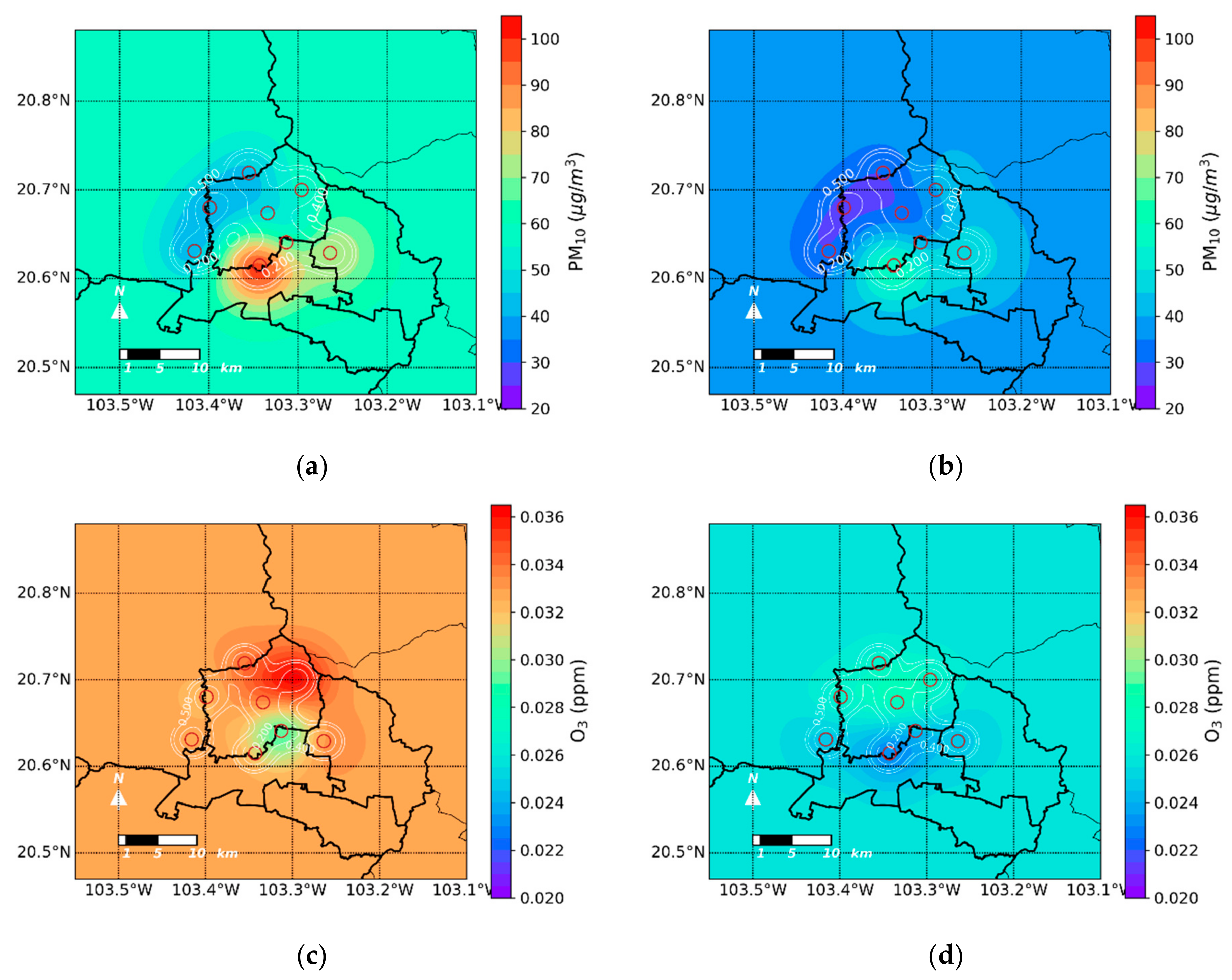
| Source of Variation | Sums of Squares 1,2,3 | Degrees of Freedom 4,5 | Mean Square 6,7 | F Ratio 8 |
|---|---|---|---|---|
| Between groups | ||||
| Within groups | ||||
| Total |
| TSS | % |
|---|---|
| I Thermal low over California * | 23.85 |
| II Low pressure system over USA * | 22.25 |
| III Low pressure system over northeastern Mexico * | 6.22 |
| IV Extended trough on the east of the Sierra Madre Oriental * | 8.55 |
| V High migratory pressures * | 26.52 |
| VI Convective-allowing situations * | 11.61 |
| Classified percentage ** | 79.15 |
| TSS | PM10 (μg/m3) | O3 (ppm) | ||
|---|---|---|---|---|
| Mean | Standard Deviation | Mean | Standard Deviation | |
| TSS I | 38.95 | 26.83 | 0.0252 | 0.0185 |
| TSS II | 58.44 | 35.69 | 0.0319 | 0.0247 |
| TSS III | 58.28 | 33.89 | 0.0289 | 0.0234 |
| TSS IV | 58.02 | 36.23 | 0.0246 | 0.0225 |
| TSS V | 58.72 | 36.13 | 0.0235 | 0.0208 |
| TSS VI | 42.94 | 28.70 | 0.0299 | 0.0216 |
© 2018 by the authors. Licensee MDPI, Basel, Switzerland. This article is an open access article distributed under the terms and conditions of the Creative Commons Attribution (CC BY) license (http://creativecommons.org/licenses/by/4.0/).
Share and Cite
Fonseca-Hernández, M.; Tereshchenko, I.; Mayor, Y.G.; Figueroa-Montaño, A.; Cuesta-Santos, O.; Monzón, C. Atmospheric Pollution by PM10 and O3 in the Guadalajara Metropolitan Area, Mexico. Atmosphere 2018, 9, 243. https://doi.org/10.3390/atmos9070243
Fonseca-Hernández M, Tereshchenko I, Mayor YG, Figueroa-Montaño A, Cuesta-Santos O, Monzón C. Atmospheric Pollution by PM10 and O3 in the Guadalajara Metropolitan Area, Mexico. Atmosphere. 2018; 9(7):243. https://doi.org/10.3390/atmos9070243
Chicago/Turabian StyleFonseca-Hernández, Mariam, Iryna Tereshchenko, Yandy G. Mayor, Arturo Figueroa-Montaño, Osvaldo Cuesta-Santos, and Cesar Monzón. 2018. "Atmospheric Pollution by PM10 and O3 in the Guadalajara Metropolitan Area, Mexico" Atmosphere 9, no. 7: 243. https://doi.org/10.3390/atmos9070243
APA StyleFonseca-Hernández, M., Tereshchenko, I., Mayor, Y. G., Figueroa-Montaño, A., Cuesta-Santos, O., & Monzón, C. (2018). Atmospheric Pollution by PM10 and O3 in the Guadalajara Metropolitan Area, Mexico. Atmosphere, 9(7), 243. https://doi.org/10.3390/atmos9070243





